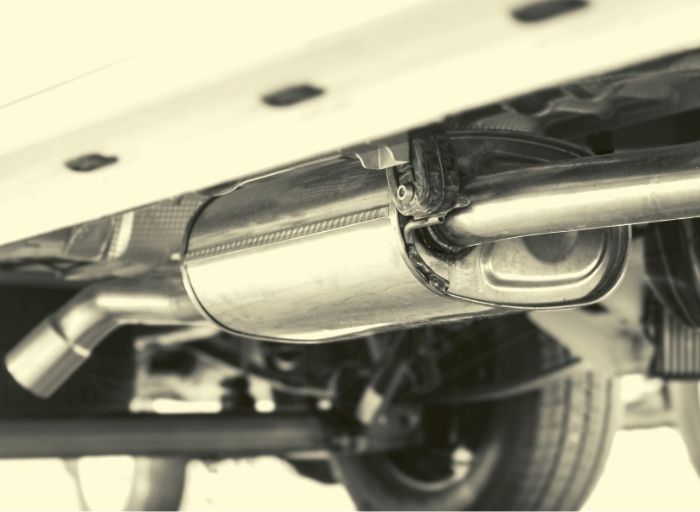
A catalytic converter is an important part of your car that is normally built to last the lifespan of the vehicle. However, if it breaks down, it may be difficult to pay for such an expensive item, even if doing so may prevent more engine problems. As a result, some people may wonder how to fix catalytic converter without replacing it. Or even whether it is an option at all.
The short answer is that a catalytic converter can be repaired without replacing it, but only if it hasn’t become so bad that it rattles, is discolored, warped, or emits a sulfur odor.
Table of Contents
What Is a Catalytic Converter?
A catalytic converter is a piece of equipment that is fitted in an internal combustion vehicle’s exhaust system. It has a honeycomb structure on the interior and is box-shaped.
Its major job is to process and render less harmful all of the gases and pollutants produced during the combustion process. The catalytic converter’s goal is to reduce the amount of smog and other toxins produced by the vehicle, which are harmful to both the environment and individuals. Mostly because we breathe these gases, which can have a variety of effects on our bodies.
How Do They Work?
Electronic controls and emissions control systems, such as catalytic converters, have made today’s automobiles cleaner and more powerful than ever before. Fuel interacts with oxygen in the air in your engine, which is ignited by a spark or the heat of compression. This chemical reaction should produce just motive energy, water vapor (H2O), and carbon dioxide in an ideal world (CO2). However, the ideal is difficult to fulfill in real-world driving conditions, resulting in hazardous emissions.
The catalytic converter oxidizes and reduces toxic pollutants using precious metals and intense heat, turning them into safer chemicals like H2O, CO2, and nitrogen (N2). Catalytic converters are expensive, costing upwards of $1,000, due to the manner they are made, employing precious metals such as platinum, palladium, and rhodium (not inclusive of diagnosis and installation).
Symptoms of A Broken Catalytic Converter
There are several symptoms that a catalytic converter is having problems, but those problems may not necessitate replacement. It’s possible that it’s just clogged or unclean. Hence it’s crucial to understand the indications that indicate whether your catalytic converter needs to be replaced or cleaned.
Signs that it’s time to clean your catalytic converter
If your catalytic converter does not rattle, has discoloration, warping, or a sulfur(rotten egg) odor, cleaning it instead of replacing it may be an option. These are some of the warning signs:
#1 Check engine light has turned on
Some individuals overlook the check engine light because they believe it will cost them a lot of money at the dealer, but it is something you should be aware of if it appears. This is usually the first clue that the catalytic converter is malfunctioning.
A light indicating that you should inspect your engine does not imply that you should run to a dealer. A scanner known as an OBD2 is an excellent investment. This diagnostic tool can provide you with codes that correspond to specific car issues.
#2 Your vehicle’s performance degrades
When your catalytic converter becomes clogged, it is unable to release gases as quickly as it should, causing the engine to “choke.” As a result, the vehicle’s efficiency suffers, and its performance suffers as a result.
#3 A sluggish start or poor acceleration
If you’re having difficulties starting or accelerating your car, the catalytic converter may be the source of the problem. Clogs could be blocking gases from exiting the exhaust system, causing your engine to suffocate.
#4 Reduced gas mileage
Bad gas mileage is a surefire sign of a blocked catalytic converter. Because the exhaust sends some toxins back into the engine, the fuel to air ratio changes. This has an effect on the combustion reaction, which reduces your gas mileage and performance.
Signs that it’s time to replace your catalytic converter
If you have any of the symptoms listed below, your catalytic converter may not be repairable, and your only option is to replace it:
#1 Warping or discoloration
A change in the appearance of your catalytic converter indicates that it needs to be replaced. It has an interior leak or is persistently overheated if it is discolored or warped.
#2 Noises that rattling
It’s critical to always pay attention to the sounds your automobile makes, since they can reveal a lot about the issues it’s having. One of them is the sound of the converter creaking.
When the metals inside the converter’s filtering mechanism, which resembles a honeycomb, start breaking off, this sound occurs. They can start to tremble as they crumble.
#3 Sulfur Odor
While a sulfur odor can be caused by a failed catalytic converter or one that only needs cleaning, it usually occurs because the poisons cannot be converted into less hazardous compounds.
The smell, which is reminiscent of rotten eggs, will be strongest near the exhaust. The catalytic converter, in particular, does not convert hydrogen sulfide, which is formed when a vehicle burns a gas, into sulfur dioxide, which generates the odor.
Another indicator of the sulfur odor is that the liquid that comes out of your car is much darker than usual. A plume of black smoke could potentially be the culprit.
How to Fix Catalytic Converter without Replacing it
Here’s how to get your catalytic converter working again without having to replace it:
#1 Drive hard
This method of clearing a clogged catalytic converter is undoubtedly familiar to you. Although it is not something that manufacturers encourage, it does work. And if your catalytic converter is failing, you should follow this suggestion first because it is the simplest and will save you a lot of money.
When you drive a car in a city with slow traffic, your catalytic converters may become clogged with these harmful particles. The reason for this is that the catalytic converters are not reaching operational temperature. They don’t become hot enough to burn the particles, so they linger around and cause blockage. However, an Italian tune-up may be able to save you in this situation.
Running your automobile at high RPM and high speed for a few minutes on the highway is the science behind this. This will get your catalytic converters up to operating temperature and burn any debris clogging them up. Between 800 and 1832 degrees Fahrenheit is the sweet spot. Run your automobile through the gears a few times, trying to get near to the redline at high rpm.
At this temperature, something magical happens, and all of the gunk within your converters burns off and dissolves. However, there is no assurance that it will work, particularly if your catalytic converter is too old and clogged. In that scenario, only a thorough cleaning, which we shall explain later, can assist.
#2 Additives to the fuel
Using a gasoline additive on a regular basis will improve the performance of your engine and aid in the cleaning of your catalytic converter. This is especially true for those who use standard gasoline instead than premium or super-premium fuel, as the latter contains additives.
Those experiencing troubles with engine performance, poor gas mileage, or other catalytic issues should try switching to premium or super-premium gas for a while to see if it improves or cures the problem.
You might use lacquer thinner to accomplish this. Simply pour a full gallon of the thinner into a half-filled gas tank. Then, for around 150 miles, go on a road trip where you can drive at highway speeds. Another approach is to run the vehicle in the driveway for about a half-hour at around 2500 RPMs.
#3 Give your catalytic converter a wash
You can try cleaning your catalytic converter, but this will necessitate removing it from the vehicle. This may sound intimidating to someone who isn’t used to working with machines, but it’s not as difficult as it appears. All you have to do now is remove the converter and pressure wash out all of the debris that has accumulated within.
To get it all, you’ll have to clean the part from both the front and back ends.
Soak the part in hot water with a basic laundry detergent or degreaser to achieve a thorough clean. Make sure to use anything that can get rid of the thick grease build-up. After that, power wash it, properly dry it, and replace it.
How to Extend the Life of Your Catalytic Converter
The catalytic converter may need to be changed in some cases (for example, if it is destroyed or melted down). If you need to replace your catalytic converter, follow these guidelines to ensure it lasts as long as possible.
Cars enjoy being driven
Don’t leave your automobile unattended for weeks, and make a point of going on a few longer journeys rather than just small ones. Once a week, spend at least 20 minutes driving at highway speeds to establish an appropriate operating temperature.
Maintain your vehicle with routine maintenance
Maintain your vehicle with routine maintenance such as oil changes, air filter changes, and inspections. If you or your technician notices anything that requires attention, take care of it soon away to avoid damaging the catalytic converter.
Keep an eye on the check engine light
The check engine light should be addressed as soon as possible. If the MIL illuminates, the engine is most likely operating in an open loop, relying on programming rather than input. The engine may run excessively rich or too low in an open loop, which might damage the catalytic converter.
Use the right fuel
If you discover that switching to high-octane fuel fixes your catalytic converter problem, consider doing so at least once a year. The initial switch cleans the catalytic converter, but a permanent switch might keep it in good working order for the rest of your vehicle’s life.
Conclusion
When a catalytic converter fails, it can produce a variety of symptoms, including a foul odor, sluggish performance, and low power. Make certain you understand how to repair a catalytic converter without having to replace it. I strongly advise you to drive on the highway frequently. This will assist your catalytic converters in heating up and burning the obstructing particles.
Hi there! I’m Naomi O’Colman. I’ve got years of experience working at an auto repair shop here in Texas under my belt. On top of that, ever since I was a kid I’ve been passionate about the auto industry. Since I’ve joined the team at automotivegearz.com I’ve been enthusiastically sharing my passion and insights with my readers. I’m dedicated to delivering high quality content and helping you stay up to date with the latest automotive trends and products out there!







